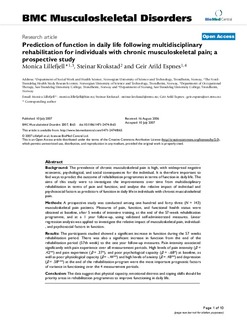| dc.description.abstract | Background: The prevalence of chronic musculoskeletal pain is high, with widespread negative economic, psychological, and social consequences for the individual. It is therefore important to find ways to predict the outcome of rehabilitation programmes in terms of function in daily life.
The aims of this study were to investigate the improvements over time from multidisciplinary rehabilitation in terms of pain and function, and analyse the relative impact of individual and psychosocial factors as predictors of function in daily life in individuals with chronic musculoskeletal pain.
Methods: A prospective study was conducted among one hundred and forty three (N = 143) musculoskeletal pain patients. Measures of pain, function, and functional health status were obtained at baseline, after 5 weeks of intensive training, at the end of the 57-week rehabilitation programme, and at a 1 year follow-up, using validated self-administrated measures. Linear regression analysis was applied to investigate the relative impact of musculoskeletal pain, individual- , and psychosocial factors in function.
Results: The participants studied showed a significant increase in function during the 57 weeks rehabilitation period. There was also a significant increase in function from the end of the rehabilitation period (57th week) to the one year follow-up measures. Pain intensity associated significantly with pain experience over all measurement periods. High levels of pain intensity (β =
.42**) and pain experience (β = .37*), and poor psychological capacity (β = -.68*) at baseline, as well as poor physiological capacity (β = -.44**) and high levels of anxiety (β = .48**) and depression (β = .58***) at the end of the rehabilitation program were the most important prognostic factors of variance in functioning over the 4 measurement periods.
Conclusion: The data suggest that physical capacity, emotional distress and coping skills should be priority areas in rehabilitation programmes to improve functioning in daily life. | nb_NO |

